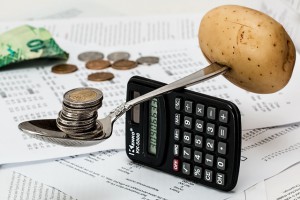Beginners trying to tackle their personal finances for the first time see debt as sort of a “boogeyman”, a specter that looms overhead, trying to trap people into inescapable cycles of minimum payments and late fees. Or at the very least, something to be avoided whenever possible.
Deep down, we all know this is not really the case. Having a healthy amount of debt is almost an essential part of growth, but taking on lots of small debts frequently can also be very dangerous to your bottom line.
Distinguishing Good Debt from Bad Debt
When we talk about “Good Debt”, it usually refers to debt that was taken on to help advance your future income or net worth. Bad debt, on the other hand, is debt that is taken on for no real long-term gain.
Examples of Good Debt
 Good debt can include things like:
Good debt can include things like:
- Student loans to get a new degree or certification that improves your job prospects
- Mortgage on a house
- Refinancing a loan on your house for home improvements
- A car loan
- Short-term credit card debt
In all of these cases, the debt is taken on to serve some specific purpose. Student loans to go to school is a long-term investment in making yourself a higher income earner. Taking out a mortgage to buy a house can greatly increase your net worth in the long run, and mortgage payments can frequently be lower than rental payments.
Refinancing your home means taking out a loan based on the equity you have built up through past payments – this can be a good way to reduce your interest rates, or finance home improvements that can make your home more valuable before selling it. Car loans greatly increase the range that you can work from your current home, and short-term credit card debt can be beneficial, depending on your bank fees and credit card perks.
When Good Debt Goes Bad
 All of the examples above are examples of debt taken on for exactly the right reasons, but this debt can still turn “bad”, or become simply a burden to your personal finances.
All of the examples above are examples of debt taken on for exactly the right reasons, but this debt can still turn “bad”, or become simply a burden to your personal finances.
- You may drop out of school or not finish your degree
- The interest you pay on your home mortgage may be greater than the property’s increase in value over the course of the loan
- You may refinance your home loan at a less favorable interest rate, or add some of the loan amount to your working cash or savings directly
- You may take out a car loan and end up with a “lemon”, or a car in constant need of repairs
- A crisis may hit, causing your credit card balances to start piling up
All of these transformations can happen with little notice, but good financial planning lets you identify the risk before you take on debt and help plan for when things go wrong.
Identifying Risk
Identifying risk before taking on debt is an exercise in financial planning – looking at what you are expecting, and determining the chances that something might go wrong. The later chapters of this course will go into more detail in how to identify certain types of risk, but here are some of the factors to look for in the debt we have above:
Student Loans
 Before choosing what to study or your specific career path, make a list of your top 5 choices (between university, trade school, or directly joining the job market). Look up some jobs in each of those fields – how much do they pay? How much competition is there to get your first job?
Before choosing what to study or your specific career path, make a list of your top 5 choices (between university, trade school, or directly joining the job market). Look up some jobs in each of those fields – how much do they pay? How much competition is there to get your first job?
This can help you visualize not just what you need to do to succeed in each of your desired paths, but how likely taking on this debt is going to pay off.
Home Mortgages
Think about how long you plan on living in a home – 5 years, or 30? How have property values moved up or down in this area over time, and how does that line up with the property market as a whole? If you lose your job, how long can you keep paying the mortgage? Remember – when you are renting, it is much easier to move somewhere cheaper than trying to sell a home.
Refinancing A Loan
Before you refinance a home loan, carefully consider how much you need that loan. Refinancing for a better interest rate is usually a smart move, but investing in home improvements can be trickier. It is not a good idea to refinance a mortgage just to deposit the cash in your bank account, but it can be a last resort to cover other bad debts.
Keeping Your Debt Good
Most of this might seem obvious, but how can you keep your debt from turning bad?
 The key is being able to look frankly at your potential purchase, and try to remove your emotions from the decision. Is this debt something that will really help your position in the long run? If so, make an itemized list of the risks.
The key is being able to look frankly at your potential purchase, and try to remove your emotions from the decision. Is this debt something that will really help your position in the long run? If so, make an itemized list of the risks.
Next, see how taking on this debt impacts your budget or spending plan. Long term debt is considered a “Fixed Need”, while short term credit card debt is a “Variable Need”.
If all of this sounds like a lot of work before making a purchase, you’re right! It is! Taking on debt is always something to carefully consider, because it will make a significant dent in your ability to meet your other financial goals.
If you are in control of your personal finances, you will likely have good debt balances taking up a sizable piece of your monthly spending. If you are starting to fall out of control, you might find those good debts turning bad, and need to find a way to dump them as quickly as possible.
Pop Quiz
[mlw_quizmaster quiz=97]
